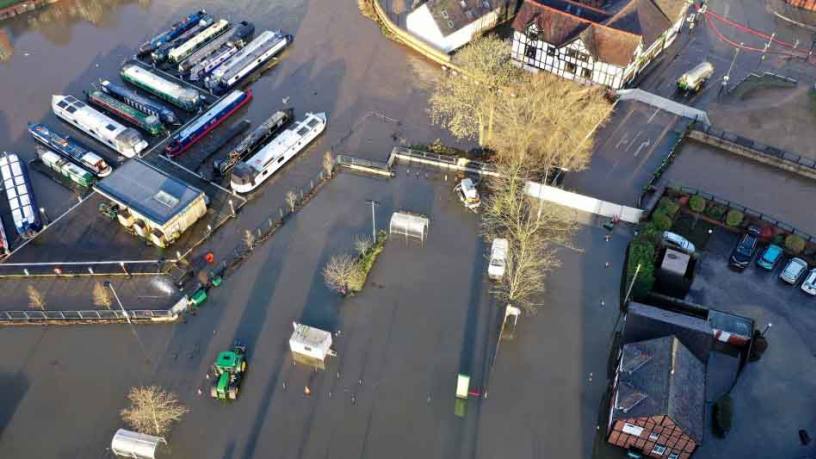This year began with a sharp reminder of the devastating impact that flooding can have on land and infrastructure in the UK.
It came in the form of Storm Christoph, a slow-moving Atlantic depression that brought torrential rain and blizzard conditions to large parts of the country. Hundreds of properties were damaged as several months’ worth of rain fell in a matter of days, with the UK Meteorological Office issuing a series of red and amber warnings.
However, while Storm Christoph had huge repercussions for hundreds of UK homeowners, previous storms have caused more severe challenges. Storms Desmond, Eva and Frank in 2016, for example, led to almost 15,000 insurance claims to be made, causing damage totalling £1.3bn – a far cry from the impact of Storm Christoph, with PwC predicting the insured losses for this latest storm hitting £120m.
Although there are obvious differences between these storms that have hit the UK in the past decade, the message is clear: as our environment changes, this trend of climate-induced extreme events is only set to continue in the years to come and is likely to have enormous financial ramifications – not just for homeowners, but for the banking sector itself.
Take the recent landslip in Slaithwaite in Yorkshire for example, which threatened damage to a new housing development project in the area. Or the mine blowout in Skewen, Wales that forced 80 residents out of their homes. Such stories will become increasingly frequent over the next 50 years or so and instances like these will have a direct and profound impact on UK banks invested in affected properties and land.
The trend of climate-induced extreme events is only set to continue in the years to come and it’s likely to cause enormous financial ramifications for the banking sector
Christoph certainly will not be the last storm we see in the UK. As weather-induced events increase in severity and frequency over the long-term, the UK banking sector may need to think more carefully about the impact on its assets and investments.
UK bank assets total $10.8tn, the largest in Europe. A large part of those assets take the form of property, land and infrastructure which are increasingly vulnerable to adverse weather and the implications of climate change.
Following the warmest January on record in 2020, McKinsey surveyed 46 banks across the EU, paying close attention to the composition of their portfolios . The study found that more than 15% of bank balance sheets were at risk due to high investment in real estate, non-green energy production such as coal plants, and the meat and dairy industry, which is increasingly vulnerable to crop failures.
Put simply, if banks want to invest in their own future and prepare for the long-term impact of climate change, identifying and managing the various physical risks that will come with this will need to take priority.
Risk management
Risk management is hard-coded into any successful financial operation. For the majority of institutions, this will take the form of financial stress-testing or cybersecurity, but for the banking sector, going beyond this will be key.
The environment itself is posing a risk to banks’ asset portfolios in the form of floods and heavy rainfall in the short term, and more extreme weather events like storms and heatwaves over the long term – all of which can severely affect property, land and infrastructure through issues like subsidence, coastal erosion and landslides. Assessing and understanding the physical risks of climate change should therefore be at the top the banking sector’s risk management agenda.
This is where implementing and utilising physical risk models will stand banks in good stead. Accessing property and climate-specific data will deliver valuable insights for lenders, enabling them to understand how the complex physical risks of climate change – such as those associated with ground instability – could affect their underwriting decisions with regards to property and land. The key word here is ‘specific’: provided banks have access to scalable and granular physical risk information, they will be able to make smarter decisions when it comes to lending against and investing in assets, both in the present day and in the future.
This is particularly pertinent given that in 2019 the then governor of the Bank of England, Mark Carney, announced that the 2021 Biennial Exploratory Scenario would explore the financial risks posed by climate change. The scenario will require all financial services firms, including banks, to report on their climate-related risks by the end of this year, further emphasising the need for the market to gear up for the physical risks of our changing climate.
While combatting such global issues is usually the responsibility of regulation-setters and lawmakers, it turns out that UK banks and other financial institutions are also on the frontline of this particular battle, but for very different reasons.
While the financial services industry now well understands the risks posed by flooding in the UK, physical risks such as subsidence, coastal erosion and landslides are evolving and will increase more rapidly than ever before. It is time the banking sector started preparing for these future climate hazards. Could Storm Christoph be the reminder the industry needs?
Tom Backhouse is the chief executive of consultancy Terrafirma.













